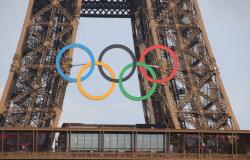Made aware of the attacks perpetrated by Abbé Pierre, the Vatican tried to prevent the famous French priest from coming to Canada in 1959, reveal archives of the French Catholic Church consulted by the newspaper Release. Here in Quebec, Catholic authorities claim to have no documents in their archives related to Abbot Pierre’s visits. According to a count of Dutythe priest traveled at least nine times in the province. Have archives been destroyed, as recommended by an instruction given by a father to religious archivists in 1991?
In an effort to be transparent, the bishops of France agreed, earlier this month, to open their archives to shed light on the attacks committed by Abbé Pierre and having been documented in two reports commissioned by the Emmaüs group. .
According to the revelations of Releasethe Vatican had been informed of the actions of Henri Grouès — the real name of Abbé Pierre — since at least 1959, and the Holy See tried to prevent the founder of Emmaus from traveling to Canada.
On January 27, 1959, Mr.gr Paolo Marella, the apostolic nuncio in Paris (the Vatican ambassador to France), writes to Mgr Jean-Marie Villot, who heads the secretariat of the Assembly of Cardinals and Archbishops in France: “The Holy See orders Abbot Pierre to immediately suspend the trip he intends to make to Canada due to the difficulties that have been reported by the country’s bishops. »
Release mentions that, in the letter, “the tone is firm even if the terms remain cryptic, as is usual in the Catholic Church when it comes to sexual excesses of priests.” Further, the newspaper adds that “reading the Vatican message, it was the Canadian bishops who, at least this time, raised the alarm.” Abbé Pierre nevertheless went to Quebec in 1959.
No traces in the archives
The authorities of the Catholic Church in the country say they have not found any traces in their archives of correspondence or documents linked to Abbot Pierre’s travels.
In response to questions from Dutythe Canadian Conference of Catholic Bishops maintains that it has not “found any documentation on Abbé Pierre”. The Diocese of Montreal claims not to have “detailed or exhaustive archives on the activities of Abbot Pierre during his stay in Quebec.” As for the Diocese of Quebec, it mentions having “spotted no information concerning Abbé Pierre”.
A press review carried out by Duty made it possible to establish that the founder of Emmaüs traveled to Quebec on at least nine occasions, namely in the summer of 1956, in the winter of 1958, in the autumns of 1959-1961-1962-1963 and in the summers of 1991- 2000-2004. During these trips, Abbé Pierre went several times to Quebec, where an Emmaüs counter was inaugurated in 1959. He also went to Montreal, Chicoutimi, Sherbrooke, Granby and Gatineau, among others.
After the Vatican tried to prevent Abbé Pierre from coming to Canada, the man traveled to Quebec at least seven times.
These trips also took place after the French Catholic Church and the Emmaus organization, presumably aware of the prelate’s actions, had sent him to a psychiatric clinic in Switzerland for six months, in 1957-1958. “The real reason for this distance is the fear of a sexual scandal,” historian Axelle Brodiez-Dolino, author of the book, told France Inter. Emmaus and Abbot Pierre.
Victims in Quebec?
Documents revealed by Release and France Inter suggest that Abbé Pierre caused victims in Quebec. Both media outlets had in hand a handwritten letter written by Abbot Pierre on September 6, 1959 while he was staying at Oka Abbey. In a scathing tone, he responded to a Quebec reverend who was aware of “accusations” against him: “None of these miserable police acts that you spoke of have never existed anywhere. »
France Inter also published the testimony of a French theologian claiming that a Quebec priest had confided to him in 1963 that Abbé Pierre had committed sexual assaults on women in Montreal and that the Catholic Church and the police were aware .
Destroy files
Is it therefore possible that documents of the Catholic Church in the country have been destroyed? In a document (a letter) filed Friday in the Superior Court of Quebec as part of the collective action targeting the Brothers of Christian Instruction, we learn that an instruction was given in 1991 to Church archivists for encourage the “destroy” or “place elsewhere” of documents that could prove incriminating if seized by the police.
This recommendation was formulated in a general manner and does not specifically address the case of Abbé Pierre. In this letter sent through the Regroupment of Religious Archivists, including Duty obtained a copy on Friday, Father Francis G. Morrisey — a former dean of the Faculty of Canon Law at Saint Paul University in Ottawa — recommends “conserving in ecclesiastical archives only what one would agree to see seized by the civil authorities.
“Since we are not obliged to keep everything, it would be good, before a civil case arises, to go through the archives and destroy any document that could be harmful later,” continues Father Morrisey. He adds that the destruction of documents must be done “all the more so when it has not been deemed necessary to proceed to a trial”. The letter also indicates the presence of “secret archives” in the dioceses.
In another correspondence, Father Morrisey wrote to a brother that this instruction should not be made known, “because if lawyers for the ‘victims’ ever learn that we have certain files elsewhere, they will be tempted to look for them also through of a subpoena “.
Asked about the fact that the Catholic Church of Quebec says it does not have any information in its archives on Abbé Pierre, Mr.e Alain Arsenault – who leads several collective actions against religious congregations – says he is not surprised. “They cleaned up,” he said. In the early 1990s, religious organizations became aware that denunciations of sexual assault were beginning. »






